Anticipating Changes in Lifestyles That Shape Travel Behavior in an Autonomous Vehicle Era—A Method-Oriented Systematic Literature Review
Abstract
:1. Introduction
2. Materials and Methods
2.1. Lifestyle Framework
2.2. Constitution of the Corpus
2.3. Classification of the Foresight Methods Used
3. Results
3.1. Residential Location
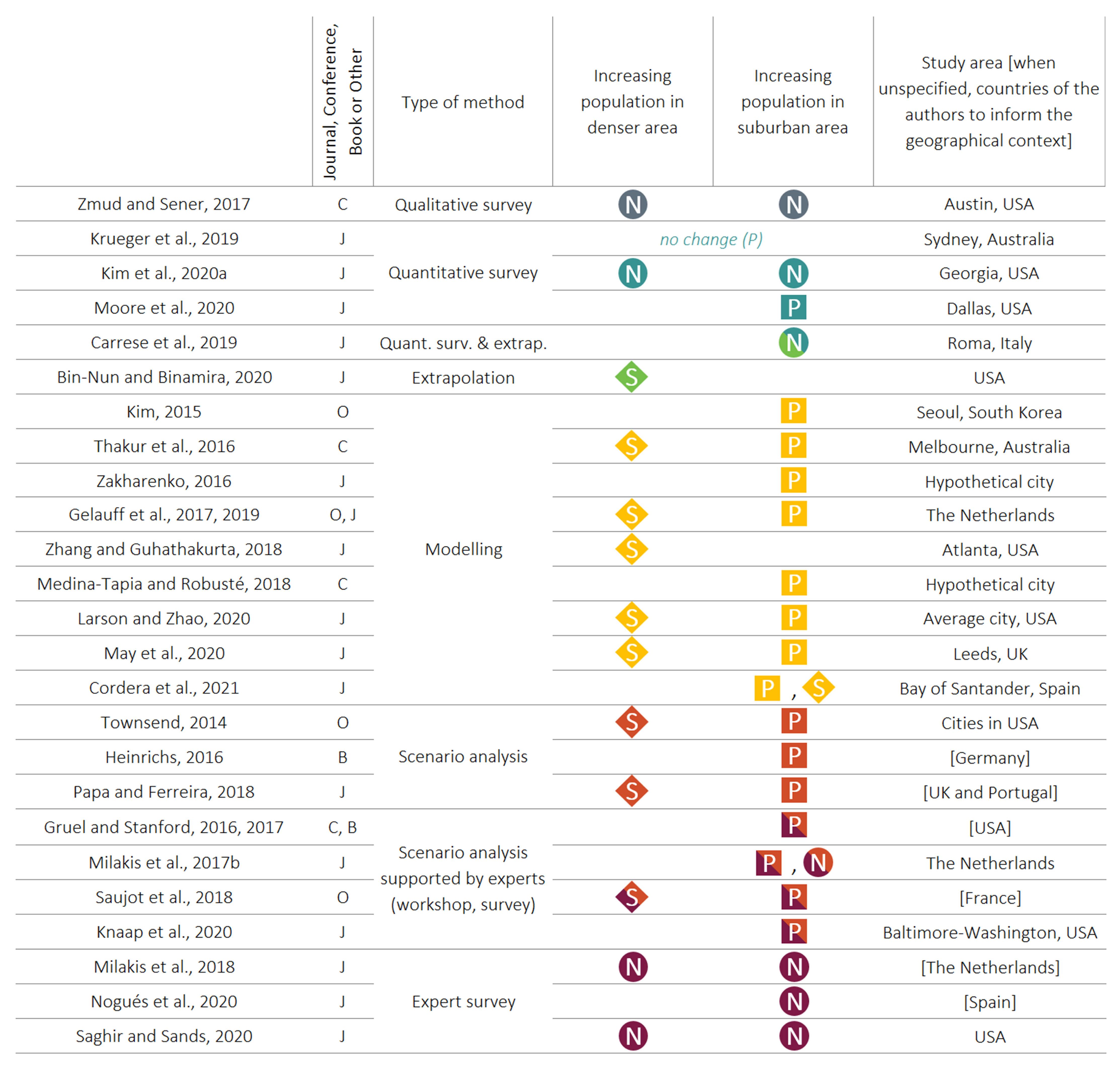
3.2. Car Ownership
3.3. Activity Patterns
3.4. Tourism
4. Discussion
4.1. The “Foresight Methods Wheel”
4.2. How to Interpret and Deal with Divergences?
4.3. Research Gaps
4.4. New Scenario Design
Supplementary Materials
Author Contributions
Funding
Data Availability Statement
Conflicts of Interest
Appendix A
| Component | Brief Description | |
|---|---|---|
| Annual to pluriannual choices | Choices about housing | This component covers the choice of a residential location (e.g., neighborhood, area type, region), type of housing (detached house, apartment), and its features (e.g., size, amenities). These choices are linked to demographic choices (e.g., parenthood) and cohabitation practices (e.g., living single or in a couple, shared rental accommodation), which reflect the structure of family models, even if they are not considered here. |
| Choices about work and income | Choices about work and income cover the choice between free time and earnings, generally corresponding to working hours, distribution of labor (within the household, over the life cycle), constraints or flexibility linked with workplace(s) (including homeworking), and other sources of income (e.g., interest on savings). | |
| Choices about vehicle ownership | This component relates to the vehicles households own and share (especially cars), their type and number, as well as the forms of access or renewal (purchase, rental or borrowing). These items provide access to services and to activities. | |
| Daily to annual choices | Day-to-day activities | This component includes the choice of activities and their characteristics. The activities in question may be imposed on individuals (e.g., household tasks) or voluntary (e.g., leisure, visits to friends). The characteristics of the activities relate essentially to their frequency and duration, location (e.g., at home, in the neighborhood), and the physical and virtual components of activities and interactions. The virtual component is linked with the use of telecommunications devices which, since the first telephone conversations, have profoundly altered the structure of activities and real mobility needs, without, however, replacing them. |
| Vacations and holidays | Choice regarding vacations and holidays refers to tourism and other leisure activities, as well as visits to family or friends, which fall outside the category of day-to-day activities. These choices are characterized by their frequency, duration and the holiday destination, the associated expenditure, and by the activities undertaken (e.g., cultural tours, sports). | |
| Travel behaviors | Mobility practices and relationship with space | Day-to-day and exceptional activities are made possible by mobility practices which do not appear on the same level in the proposed representation, but are an integral part of the studied decision-making system. Mobility is an activity that is not pursued for its own sake (economists talk of transport as “derived demand”), but the associated opportunities, constraints and choices are incorporated within activity choices (see for example certain analyses in the field of transport economics [79]). However, some of the choices—for example transport mode—may be specific to particular mobility practices, even though they may be constrained. All the places with which individuals interact in their activities constitute their living space, which generally varies from the scale of the neighborhood or village to that of the region for day-to-day activities, and goes beyond these for exceptional activities (e.g., long-distance travel, tourism). |
Appendix B. Supplementary Information Related to the “Identification Phase” Implemented to Constitute the Corpus
- Subject areas in Scopus: Social Sciences; Environmental Science; Decision Sciences; Energy, Economics and Finance; Psychology; Arts and Humanities; Multidisciplinary; and Undefined.
- Categories in Web of Science: web of science categories: social sciences interdisciplinary; behavioral sciences; planning development; transportation; environmental sciences; energy fuels; psychology; social issues; green sustainable science technology; psychology multidisciplinary; urban studies; engineering environmental; ecology; multidisciplinary sciences; geography physical; statistics probability; philosophy; environmental studies; information science library science; geography; and economics.
References
- Bali, A.S.; Capano, G.; Ramesh, M. Anticipating and Designing for Policy Effectiveness. Policy Soc. 2019, 38, 1–13. [Google Scholar] [CrossRef] [Green Version]
- Harb, M.; Stathopoulos, A.; Shiftan, Y.; Walker, J.L. What Do We (Not) Know about Our Future with Automated Vehicles? Transp. Res. Part C Emerg. Technol. 2021, 123, 102948. [Google Scholar] [CrossRef]
- Narayanan, S.; Chaniotakis, E.; Antoniou, C. Shared Autonomous Vehicle Services: A Comprehensive Review. Transp. Res. Part C Emerg. Technol. 2020, 111, 255–293. [Google Scholar] [CrossRef]
- Woo, S.; Youtie, J.; Ott, I.; Scheu, F. Understanding the Long-Term Emergence of Autonomous Vehicles Technologies. Technol. Forecast. Soc. Chang. 2021, 170, 120852. [Google Scholar] [CrossRef]
- Gandia, R.M.; Antonialli, F.; Cavazza, B.H.; Neto, A.M.; de Lima, D.A.; Sugano, J.Y.; Nicolai, I.; Zambalde, A.L. Autonomous Vehicles: Scientometric and Bibliometric Review. Transp. Rev. 2019, 39, 9–28. [Google Scholar] [CrossRef]
- Jing, P.; Xu, G.; Chen, Y.; Shi, Y.; Zhan, F. The Determinants behind the Acceptance of Autonomous Vehicles: A Systematic Review. Sustainability 2020, 12, 1719. [Google Scholar] [CrossRef] [Green Version]
- Nastjuk, I.; Herrenkind, B.; Marrone, M.; Brendel, A.B.; Kolbe, L.M. What Drives the Acceptance of Autonomous Driving? An Investigation of Acceptance Factors from an End-User’s Perspective. Technol. Forecast. Soc. Chang. 2020, 161, 120319. [Google Scholar] [CrossRef]
- Puylaert, S.; Snelder, M.; van Nes, R.; van Arem, B. Mobility Impacts of Early Forms of Automated Driving—A System Dynamic Approach. Transp. Policy 2018, 72, 171–179. [Google Scholar] [CrossRef] [Green Version]
- Galich, A.; Stark, K. How Will the Introduction of Automated Vehicles Impact Private Car Ownership? Case Stud. Transp. Policy 2021, 9, 578–589. [Google Scholar] [CrossRef]
- Pudāne, B.; Rataj, M.; Molin, E.J.E.; Mouter, N.; van Cranenburgh, S.; Chorus, C.G. How Will Automated Vehicles Shape Users’ Daily Activities? Insights from Focus Groups with Commuters in The Netherlands. Transp. Res. Part D Transp. Environ. 2018, 71, 222–235. [Google Scholar] [CrossRef]
- Zhang, W.; Guhathakurta, S. Residential Location Choice in the Era of Shared Autonomous Vehicles. J. Plan. Educ. Res. 2018, 41, 135–148. [Google Scholar] [CrossRef] [Green Version]
- Singleton, P.A.; De Vos, J.; Heinen, E.; Pudāne, B. Potential Health and Well-Being Implications of Autonomous Vehicles. Adv. Transp. Policy Plan. 2020, 5, 163–190. [Google Scholar]
- Tillema, T.; Berveling, J.; Gelauff, G.; van der Waard, J.; Harms, L.; Derriks, H. Driver at the Wheel? Netherlands Institute for Transport Policy Analysis: The Hague, The Netherlands, 2015; p. 44. [Google Scholar]
- Bridgelall, R.; Stubbing, E. Forecasting the Effects of Autonomous Vehicles on Land Use. Technol. Forecast. Soc. Chang. 2021, 163, 120444. [Google Scholar] [CrossRef]
- Duarte, F.; Ratti, C. The Impact of Autonomous Vehicles on Cities: A Review. J. Urban Technol. 2018, 25, 3–18. [Google Scholar] [CrossRef]
- Milakis, D.; van Arem, B.; van Wee, B. Policy and Society Related Implications of Automated Driving: A Review of Literature and Directions for Future Research. J. Intell. Transp. Syst. 2017, 21, 324–348. [Google Scholar] [CrossRef]
- Soteropoulos, A.; Berger, M.; Ciari, F. Impacts of Automated Vehicles on Travel Behaviour and Land Use: An International Review of Modelling Studies. Transp. Rev. 2019, 39, 29–49. [Google Scholar] [CrossRef]
- Hawkins, J.; Habib, K.N. Integrated Models of Land Use and Transportation for the Autonomous Vehicle Revolution. Transp. Rev. 2018, 39, 66–83. [Google Scholar] [CrossRef]
- Cohen, S.A.; Hopkins, D. Autonomous Vehicles and the Future of Urban Tourism. Ann. Tour. Res. 2019, 74, 33–42. [Google Scholar] [CrossRef]
- Van Wee, B.; Banister, D. How to Write a Literature Review Paper? Transp. Rev. 2016, 36, 278–288. [Google Scholar] [CrossRef] [Green Version]
- Tranfield, D.; Denyer, D.; Smart, P. Towards a Methodology for Developing Evidence-Informed Management Knowledge by Means of Systematic Review. Br. J. Manag. 2003, 14, 207–222. [Google Scholar] [CrossRef]
- Kaufmann, V.; Bergman, M.M.; Joye, D. Motility: Mobility as Capital. Int. J. Urban Reg. Res. 2004, 28, 745–756. [Google Scholar] [CrossRef]
- Wadud, Z.; Chintakayala, P.K. To Own or Not to Own—That Is the Question: The Value of Owning a (Fully Automated) Vehicle. Transp. Res. Part C Emerg. Technol. 2021, 123, 102978. [Google Scholar] [CrossRef]
- Winter, K.; Cats, O.; Martens, K.; van Arem, B. Identifying User Classes for Shared and Automated Mobility Services. Eur. Transp. Res. Rev. 2020, 12, 36. [Google Scholar] [CrossRef]
- Shaheen, S.; Martin, E.; Hoffman-Stapleton, M. Shared Mobility and Urban Form Impacts: A Case Study of Peer-to-Peer (P2P) Carsharing in the US. J. Urban Des. 2019, 26, 141–158. [Google Scholar] [CrossRef] [Green Version]
- Zmud, J.P.; Sener, I.N. Towards an Understanding of the Travel Behavior Impact of Autonomous Vehicles. Transp. Res. Procedia 2017, 25, 2500–2519. [Google Scholar] [CrossRef]
- Kim, S.H.; Mokhtarian, P.L.; Circella, G. Will Autonomous Vehicles Change Residential Location and Vehicle Ownership? Glimpses from Georgia. Transp. Res. Part D Transp. Environ. 2020, 82, 102291. [Google Scholar] [CrossRef]
- Moore, M.A.; Lavieri, P.S.; Dias, F.F.; Bhat, C.R. On Investigating the Potential Effects of Private Autonomous Vehicle Use on Home/Work Relocations and Commute Times. Transp. Res. Part C Emerg. Technol. 2020, 110, 166–185. [Google Scholar] [CrossRef]
- Krueger, R.; Rashidi, T.H.; Dixit, V.V. Autonomous Driving and Residential Location Preferences: Evidence from a Stated Choice Survey. Transp. Res. Part C Emerg. Technol. 2019, 108, 255–268. [Google Scholar] [CrossRef] [Green Version]
- Bin-Nun, A.Y.; Binamira, I. A Framework for the Impact of Highly Automated Vehicles with Limited Operational Design Domains. Transp. Res. Part A Policy Pract. 2020, 139, 174–188. [Google Scholar] [CrossRef]
- Carrese, S.; Nigro, M.; Patella, S.M.; Toniolo, E. A Preliminary Study of the Potential Impact of Autonomous Vehicles on Residential Location in Rome. Res. Transp. Econ. 2019, 75, 55–61. [Google Scholar] [CrossRef]
- Gelauff, G.; Ossokina, I.; Teulings, C. Spatial and Welfare Effects of Automated Driving: Will Cities Grow, Decline or Both? Transp. Res. Part A Policy Pract. 2019, 121, 277–294. [Google Scholar] [CrossRef]
- Kim, K.-H.; Yook, D.-H.; Ko, Y.-S.; Kim, D.-H. An Analysis of Expected Effects of the Autonomous Vehicles on Transport and Land Use in Korea; Marron Institute of Urban Management: New York, NY, USA, 2015; p. 29. [Google Scholar]
- Larson, W.; Zhao, W. Self-Driving Cars and the City: Effects on Sprawl, Energy Consumption, and Housing Affordability. Reg. Sci. Urban Econ. 2020, 81, 103484. [Google Scholar] [CrossRef]
- May, A.D.; Shepherd, S.; Pfaffenbichler, P.; Emberger, G. The Potential Impacts of Automated Cars on Urban Transport: An Exploratory Analysis. Transp. Policy 2020, 98, 127–138. [Google Scholar] [CrossRef]
- Medina-Tapia, M.; Robusté, F. Exploring Paradigm Shift Impacts in Urban Mobility: Autonomous Vehicles and Smart Cities. Transp. Res. Procedia 2018, 33, 203–210. [Google Scholar] [CrossRef]
- Thakur, P.; Kinghorn, R.; Grace, R. Urban Form and Function in the Autonomous Era. In Proceedings of the Australasian Transport Research Forum, Melbourne, Australia, 16–18 November 2016. [Google Scholar]
- Zakharenko, R. Self-Driving Cars Will Change Cities. Reg. Sci. Urban Econ. 2016, 61, 26–37. [Google Scholar] [CrossRef]
- Cordera, R.; Nogués, S.; González-González, E.; Moura, J.L. Modeling the Impacts of Autonomous Vehicles on Land Use Using a LUTI Model. Sustainability 2021, 13, 1608. [Google Scholar] [CrossRef]
- Milakis, D.; Snelder, M.; van Arem, B.; van Wee, G.P.; Homem de Almeida Correia, G. Development and Transport Implications of Automated Vehicles in the Netherlands: Scenarios for 2030 and 2050. Eur. J. Transp. Infrastruct. Res. 2017, 17, 63–85. [Google Scholar]
- Saujot, M.; Brimont, L.; Sartor, O. Mettons la Mobilité Autonome sur la Voie du Développement Durable; IDDRI Study; IDDRI: Paris, France, 2018; Volume 18, p. 48. [Google Scholar]
- Saghir, C.; Sands, G. Realizing the Potential of Autonomous Vehicles. Plan. Pract. Res. 2020, 35, 267–282. [Google Scholar] [CrossRef]
- Milakis, D.; Kroesen, M.; van Wee, B. Implications of Automated Vehicles for Accessibility and Location Choices: Evidence from an Expert-Based Experiment. J. Transp. Geogr. 2018, 68, 142–148. [Google Scholar] [CrossRef]
- Nogués, S.; González-González, E.; Cordera, R. New Urban Planning Challenges under Emerging Autonomous Mobility: Evaluating Backcasting Scenarios and Policies through an Expert Survey. Land Use Policy 2020, 95, 104652. [Google Scholar] [CrossRef]
- Gelauff, G.; Ossokina, I.; Teulings, C. Spatial Effects of Automated Driving: Dispersion, Concentration or Both? Netherlands Institute for Transport Policy Analysis: The Hague, The Netherlands, 2017. [Google Scholar]
- Townsend, A. Re-Programming Mobility—The Digital Transformation of Transportation in the United States; Rudin Center for Transportation Policy and Management: New York, NY, USA, 2014; p. 60. [Google Scholar]
- Heinrichs, D. Autonomous Driving and Urban Land Use. In Autonomous Driving; Springer: Berlin/Heidelberg, Germany, 2016; pp. 213–231. ISBN 978-3-662-48845-4. [Google Scholar]
- Papa, E.; Ferreira, A. Sustainable Accessibility and the Implementation of Automated Vehicles: Identifying Critical Decisions. Urban Sci. 2018, 2, 5. [Google Scholar] [CrossRef] [Green Version]
- Gruel, W.; Stanford, J.M. System Effects of Widespread Use of Fully Automated Vehicles—Three Scenarios. In Disrupting Mobility: Impacts of Sharing Economy and Innovative Transportation on Cities; Lecture Notes in Mobility; Meyer, G., Shaheen, S., Eds.; Springer International Publishing: Cham, Switzerland, 2017; pp. 135–148. ISBN 978-3-319-51602-8. [Google Scholar]
- Gruel, W.; Stanford, J.M. Assessing the Long-Term Effects of Autonomous Vehicles: A Speculative Approach. Transp. Res. Procedia 2016, 13, 18–29. [Google Scholar] [CrossRef] [Green Version]
- Knaap, G.-J.; Engelberg, D.; Avin, U.; Erdogan, S.; Ducca, F.; Welch, T.F.; Finio, N.; Moeckel, R.; Shahumyan, H. Modeling Sustainability Scenarios in the Baltimore–Washington (DC) Region. J. Am. Plan. Assoc. 2020, 86, 250–263. [Google Scholar] [CrossRef]
- Kellett, J.; Barreto, R.; Hengel, A.V.D.; Vogiatzis, N. How Might Autonomous Vehicles Impact the City? The Case of Commuting to Central Adelaide. Urban Policy Res. 2019, 37, 442–457. [Google Scholar] [CrossRef]
- Menon, N.; Barbour, N.; Zhang, Y.; Pinjari, A.R.; Mannering, F. Shared Autonomous Vehicles and Their Potential Impacts on Household Vehicle Ownership: An Exploratory Empirical Assessment. Int. J. Sustain. Transp. 2019, 13, 111–122. [Google Scholar] [CrossRef]
- Liljamo, T.; Liimatainen, H.; Pöllänen, M.; Viri, R. The Effects of Mobility as a Service and Autonomous Vehicles on People’s Willingness to Own a Car in the Future. Sustainability 2021, 13, 1962. [Google Scholar] [CrossRef]
- Glus, P.; Rothman, E.; Iacobucci, J. Driverless Future: A Policy Roadmap for City Leaders; Arcadis: Amsterdam, The Netherlands, 2017; p. 48. [Google Scholar]
- Zhang, W.; Guhathakurta, S.; Khalil, E.B. The Impact of Private Autonomous Vehicles on Vehicle Ownership and Unoccupied VMT Generation. Transp. Res. Part C Emerg. Technol. 2018, 90, 156–165. [Google Scholar] [CrossRef] [Green Version]
- Schoettle, B.; Sivak, M. Potential Impact of Self-Driving Vehicles on Household Vehicle Demand and Usage; UMTRI—University of Michigan Transportation Research Institute: Ann Arbor, MI, USA, 2015; p. 18. [Google Scholar]
- Pernestål Brenden, A.; Kristoffersson, I.; Mattson, L.-G. Future Scenarios for Self-Driving Vehicles in Sweden; KTH Royal Institute of Technology: Stockholm, Sweden, 2017; p. 35. [Google Scholar]
- Enoch, M.P.; Cross, R.; Potter, N.; Davidson, C.; Taylor, S.; Brown, R.; Huang, H.; Parsons, J.; Tucker, S.; Wynne, E.; et al. Future Local Passenger Transport System Scenarios and Implications for Policy and Practice. Transp. Policy 2020, 90, 52–67. [Google Scholar] [CrossRef]
- Hägerstrand, T. What about People in Regional Science? Pap. Reg. Sci. Assoc. 1970, 24, 6–21. [Google Scholar] [CrossRef]
- Dungs, J.; Hermann, F.; Duwe, D.; Schmidt, A.; Stegmüller, A.; Gaydoul, R.; Peters, P.L.; Sohl, M. “The Value of Time” Potential for User-Centered Services Offered by Autonomous Driving; Fraunhofer IAO—Horvath & Partners: Stuttgart, Germany, 2016; p. 46. [Google Scholar]
- Cyganski, R.; Fraedrich, E.; Lenz, B. Travel-Time Valuation for Automated Driving: A Use-Case-Driven Study. In Proceedings of the 94th Annual Meeting of the TRB, Washington, DC, USA, 11–15 January 2015. [Google Scholar]
- Kim, S.H.; Mokhtarian, P.L.; Circella, G. How, and for Whom, Will Activity Patterns Be Modified by Self-Driving Cars? Expectations from the State of Georgia. Transp. Res. Part F Traffic Psychol. Behav. 2020, 70, 68–80. [Google Scholar] [CrossRef]
- Das, S.; Sekar, A.; Chen, R.; Kim, H.C.; Wallington, T.J.; Williams, E. Impacts of Autonomous Vehicles on Consumers Time-Use Patterns. Challenges 2017, 8, 32. [Google Scholar] [CrossRef] [Green Version]
- Chen, R.B.; Armington, W. Household Activity and Travel Patterns with Autonomous Vehicles: In-Vehicle Activity Decisions. In Proceedings of the Transportation Research Board 95th Annual Meeting, Washington, DC, USA, 10–14 January 2016. [Google Scholar]
- Pudāne, B.; Molin, E.J.E.; Arentze, T.A.; Maknoon, Y.; Chorus, C.G. A Time-Use Model for the Automated Vehicle-Era. Transp. Res. Part C Emerg. Technol. 2018, 93, 102–114. [Google Scholar] [CrossRef]
- Pettigrew, S.; Fritschi, L.; Norman, R. The Potential Implications of Autonomous Vehicles in and around the Workplace. Int. J. Environ. Res. Public Health 2018, 15, 1876. [Google Scholar] [CrossRef] [PubMed] [Green Version]
- Singleton, P.A. Multimodal Travel-Based Multitasking during the Commute: Who Does What? Int. J. Sustain. Transp. 2019, 14, 150–162. [Google Scholar] [CrossRef]
- Vyas, G.; Famili, P.; Vovsha, P.; Fay, D.; Kulshrestha, A.; Giaimo, G.; Anderson, R. Incorporating Features of Autonomous Vehicles in Activity-Based Travel Demand Model for Columbus, OH. Transportation 2019, 46, 2081–2102. [Google Scholar] [CrossRef]
- Zandieh, R.; Acheampong, R.A. Mobility and Healthy Ageing in the City: Exploring Opportunities and Challenges of Autonomous Vehicles for Older Adults’ Outdoor Mobility. Cities 2021, 112, 103135. [Google Scholar] [CrossRef]
- Fitt, H.; Curl, A.; Dionisio, M.R.; Ahuriri-Driscoll, A.; Pawson, E. Considering the Wellbeing Implications for an Ageing Population of a Transition to Automated Vehicles. Res. Transp. Bus. Manag. 2019, 30, 100382. [Google Scholar] [CrossRef]
- Prideaux, B.; Yin, P. The Disruptive Potential of Autonomous Vehicles (AVs) on Future Low-Carbon Tourism Mobility. Asia Pac. J. Tour. Res. 2019, 24, 459–467. [Google Scholar] [CrossRef]
- LaMondia, J.J.; Fagnant, D.J.; Qu, H.; Barrett, J.; Kockelman, K. Shifts in Long-Distance Travel Mode Due to Automated Vehicles: Statewide Mode-Shift Simulation Experiment and Travel Survey Analysis. Transp. Res. Rec. J. Transp. Res. Board 2016, 2566, 1–11. [Google Scholar] [CrossRef]
- Gurumurthy, K.M.; Kockelman, K.M. Modeling Americans’ Autonomous Vehicle Preferences: A Focus on Dynamic Ride-Sharing, Privacy & Long-Distance Mode Choices. Technol. Forecast. Soc. Chang. 2020, 150, 119792. [Google Scholar] [CrossRef]
- Perrine, K.A.; Kockelman, K.M.; Huang, Y. Anticipating Long-Distance Travel Shifts Due to Self-Driving Vehicles. J. Transp. Geogr. 2020, 82, 102547. [Google Scholar] [CrossRef]
- Zhang, P.; Jetter, A. A Framework for Building Integrative Scenarios of Autonomous Vehicle Technology Application and Impacts, Using Fuzzy Cognitive Maps (FCM). In Proceedings of the 2018 Portland International Conference on Management of Engineering and Technology (PICMET), Portland, OR, USA, 19–23 August 2018; pp. 1–14. [Google Scholar]
- Singleton, P.A. Discussing the “Positive Utilities” of Autonomous Vehicles: Will Travellers Really Use Their Time Productively? Transp. Rev. 2018, 39, 50–65. [Google Scholar] [CrossRef] [Green Version]
- Aguilera, A.; Cacciari, J. Living with Fewer Cars: Review and Challenges on Household Demotorization. Transp. Rev. 2020, 40, 796–809. [Google Scholar] [CrossRef]
- Crozet, Y.; Vickerman, R.W. France Programme de Recherche et de Développement Technologique Transports Terrestres. In Hyper-Mobilité et Politiques Publiques: Changer D’Époque? Economica: Paris, France, 2016; ISBN 978-2-7178-6862-3. [Google Scholar]
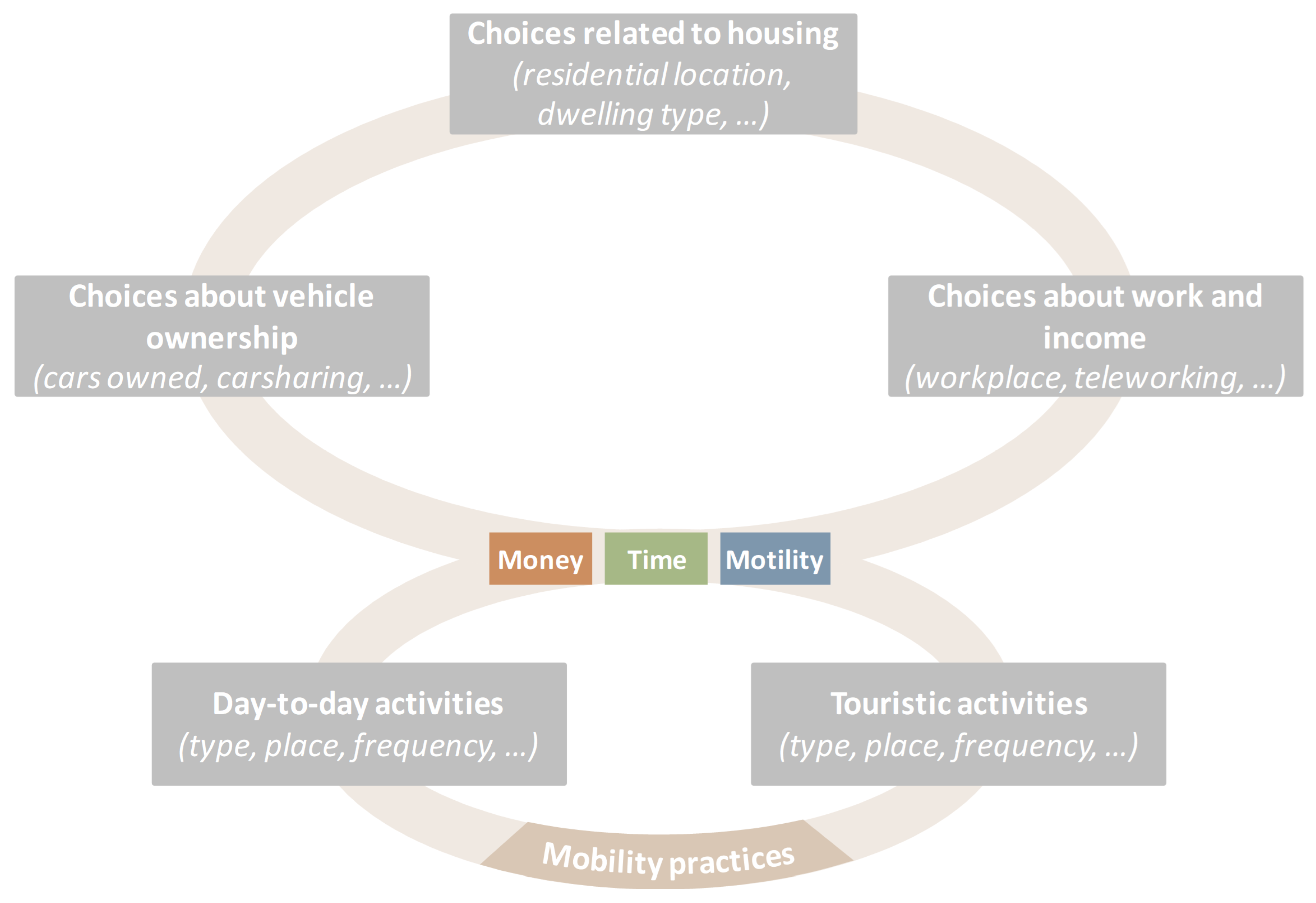
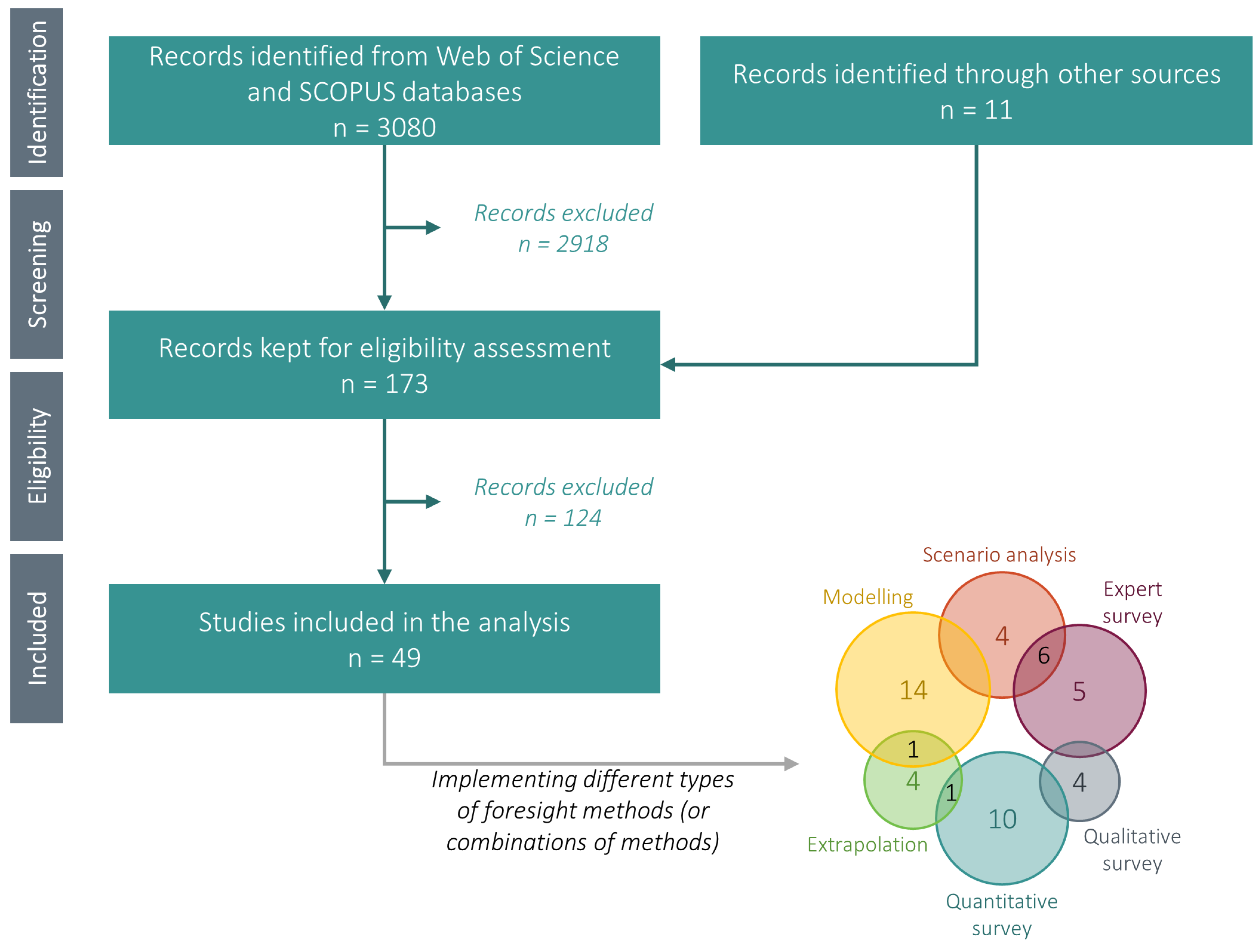
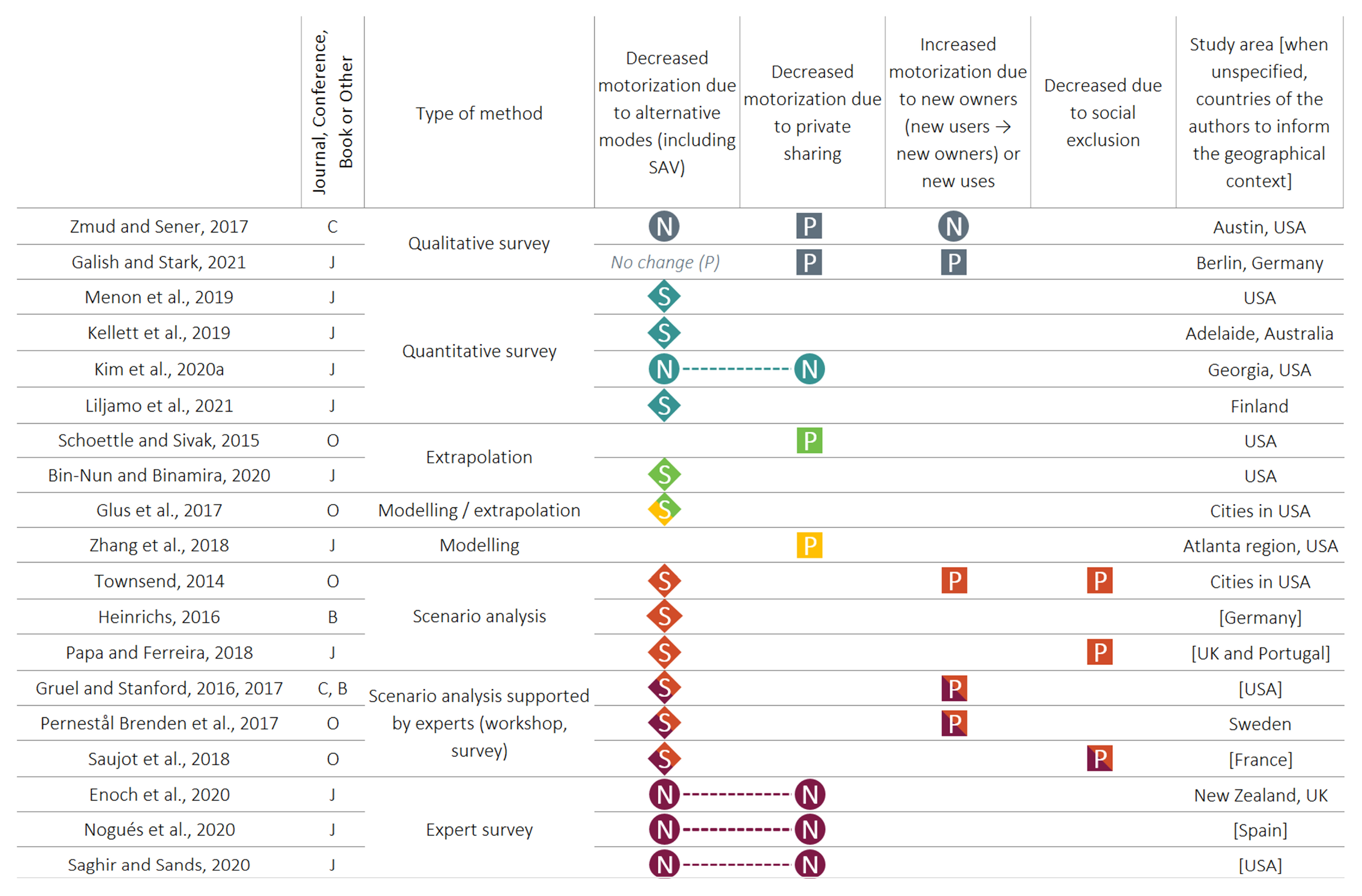
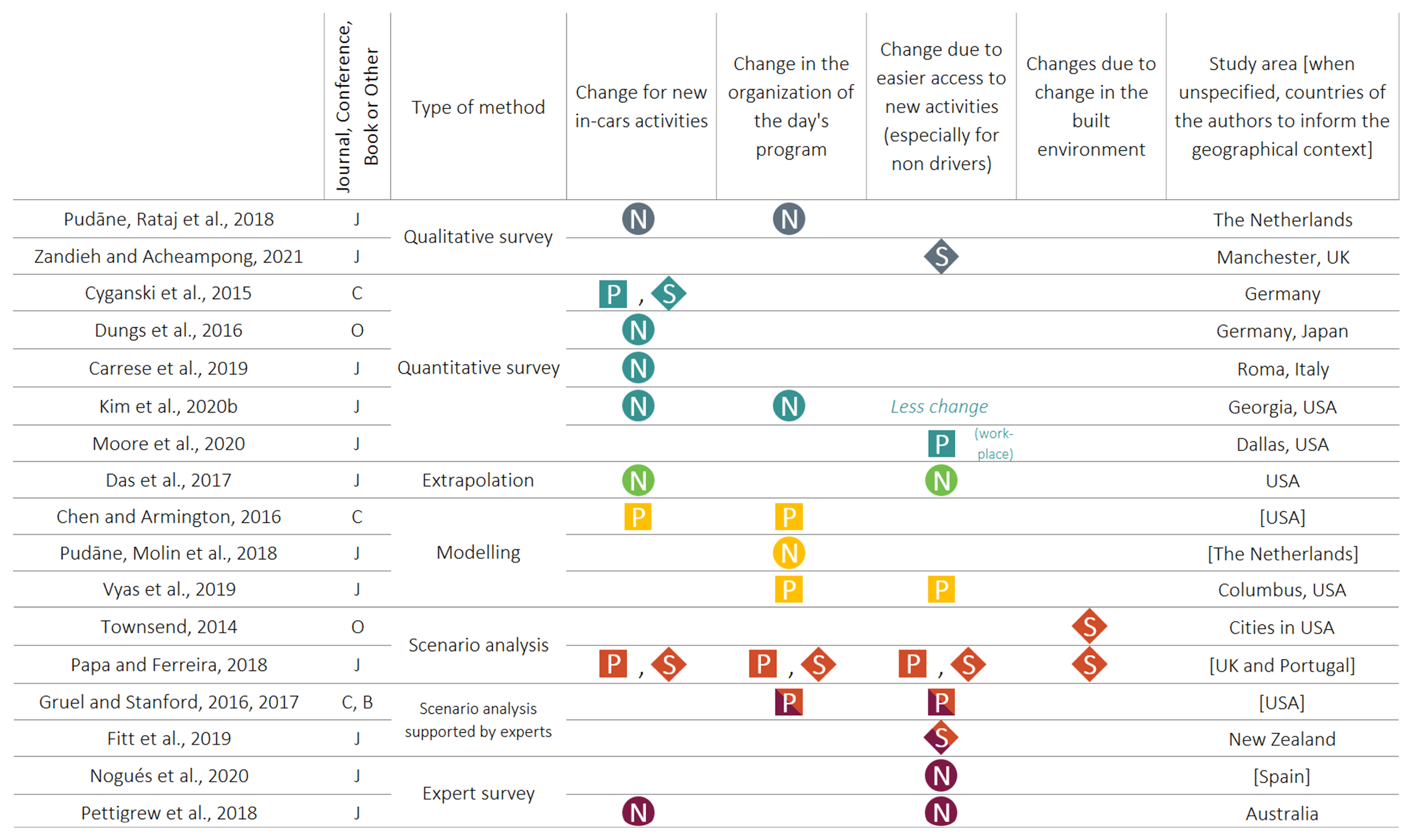
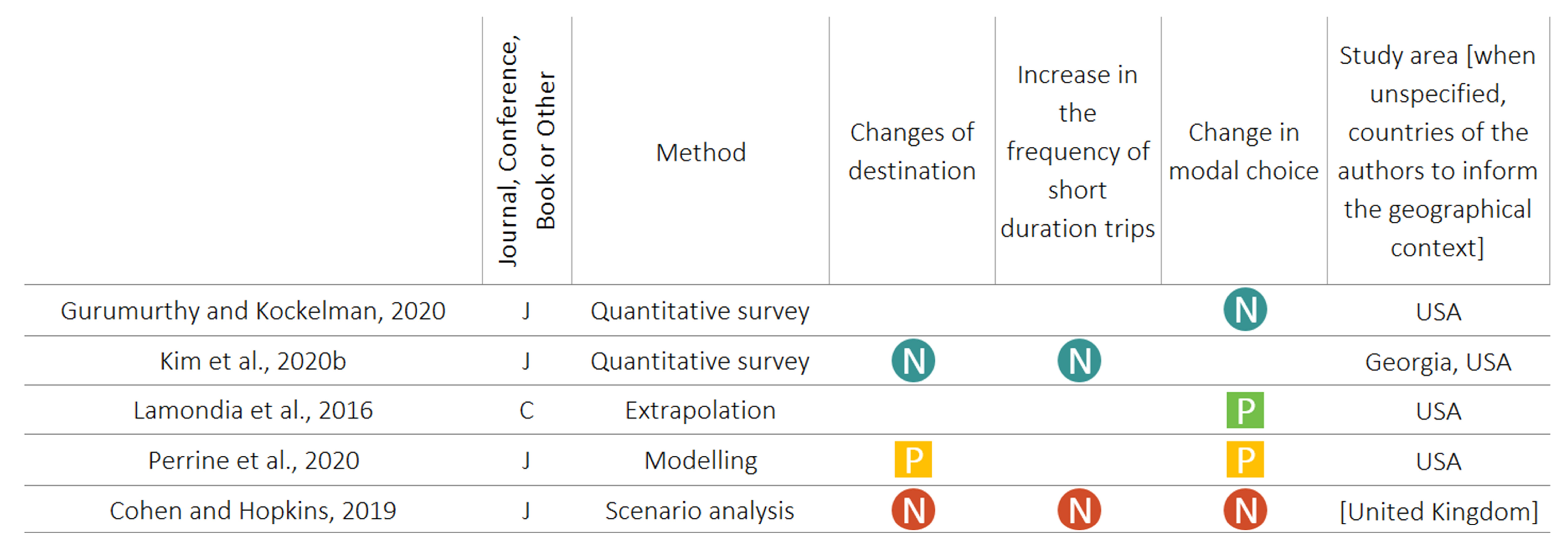

Publisher’s Note: MDPI stays neutral with regard to jurisdictional claims in published maps and institutional affiliations. |
© 2022 by the authors. Licensee MDPI, Basel, Switzerland. This article is an open access article distributed under the terms and conditions of the Creative Commons Attribution (CC BY) license (https://creativecommons.org/licenses/by/4.0/).
Share and Cite
Le Gallic, T.; Aguilera, A. Anticipating Changes in Lifestyles That Shape Travel Behavior in an Autonomous Vehicle Era—A Method-Oriented Systematic Literature Review. Future Transp. 2022, 2, 605-624. https://doi.org/10.3390/futuretransp2030033
Le Gallic T, Aguilera A. Anticipating Changes in Lifestyles That Shape Travel Behavior in an Autonomous Vehicle Era—A Method-Oriented Systematic Literature Review. Future Transportation. 2022; 2(3):605-624. https://doi.org/10.3390/futuretransp2030033
Chicago/Turabian StyleLe Gallic, Thomas, and Anne Aguilera. 2022. "Anticipating Changes in Lifestyles That Shape Travel Behavior in an Autonomous Vehicle Era—A Method-Oriented Systematic Literature Review" Future Transportation 2, no. 3: 605-624. https://doi.org/10.3390/futuretransp2030033
APA StyleLe Gallic, T., & Aguilera, A. (2022). Anticipating Changes in Lifestyles That Shape Travel Behavior in an Autonomous Vehicle Era—A Method-Oriented Systematic Literature Review. Future Transportation, 2(3), 605-624. https://doi.org/10.3390/futuretransp2030033






